Death in their eyes
SAN SALVADOR, May 12, 2015 – When your phone rings and drags you from sleep at five in the morning, there are only two possible explanations: someone dialled your number by mistake, or there is an emergency. This Friday it was no mistake.
On the end of the line was one of my sources, warning me that hundreds of highly-dangerous gang members, or “pandilleros”, were about to be moved from two prisons in the east of El Salvador, to the top-security facility of Izalco west of the capital.
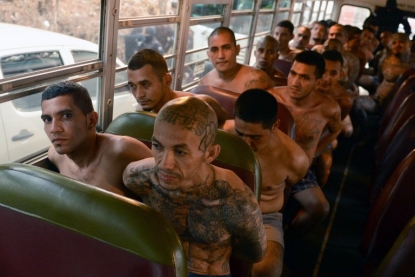 Gang members are transferred by bus to a high-security prison in Izalco, El Salvador on April 24, 2015 (AFP Photo / Marvin Recinos)
Gang members are transferred by bus to a high-security prison in Izalco, El Salvador on April 24, 2015 (AFP Photo / Marvin Recinos)For the past few weeks the prison authorities in El Salvador have been carrying out mass transfers of inmates. It’s part of a strategy to cut the channels of communication between jailed leaders of the armed gangs known here as “pandillas” or “maras”, and their lieutenants on the outside.
Inmates identified as leaders are sent to tougher penitentiary facilities. The hope is to stem a recent spike in violence linked to organised crime which has left 1,124 people dead in the first three months of this year, in a country of just six million people. The victims are soldiers, police, civilians caught in the crossfire and, especially, members of rival gangs.
Weapons in jail
I jump out of bed and head to the Izalco prison, which is about to take in 400 inmates from the prisons of Ciudad Barrios and Chalatenango. When I get there at around 8 am, the penitentiary doors have already closed on a first group of gangsters who arrived an hour earlier. Frustrating. I call my source who tells me to sit tight: the huge majority of the prisoners, around 300 members of the feared Mara Salvatrucha, MS 13, have yet to leave Ciudad Barrios.
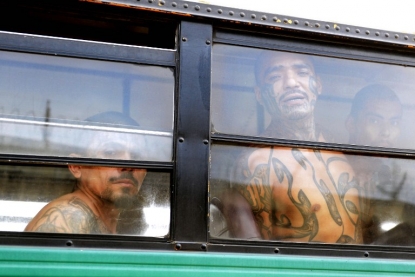 (AFP Photo / Marvin Recinos)
(AFP Photo / Marvin Recinos)While I wait I receive another message: “The operation is delayed. They found weapons and illicit substances in the prison so the buses are not going anywhere right now.” Seems like I am in for the long haul. I get chatting with the soldiers patrolling in the area, with the relatives of inmates who complain of the greater distance the transfer will mean for them, and with fellow journalists. Hanging around has always been part of the job.
Bare-chested and handcuffed behind their backs
It is five in the afternoon when the two prison buses roll up the track to the jail, flanked by a squad of police cars. The first has tinted windows and it’s impossible to make out anything inside. But the second has a few windows cracked open. It’s now or never.
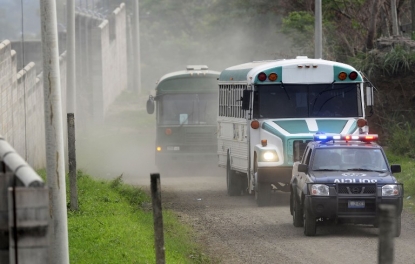 (AFP Photo / Marvin Recinos)
(AFP Photo / Marvin Recinos)All I am thinking about is my picture. I train my camera on the open windows and start shooting, ignoring the insults, grimaces and murderous looks of the thugs who are packed inside the bus, bare-chested with hands cuffed behind their backs.
I quickly switch lens and try to photograph the inmates’ eyes through the grimy windows. Suddenly, in my viewfinder appears a face entirely covered in tattoos. When he realises I am taking his picture he blows me a kiss and bursts out laughing. A few minutes later the prison doors swing open and the buses vanish inside. I have had just two minutes to work, but it was enough. I have my picture.
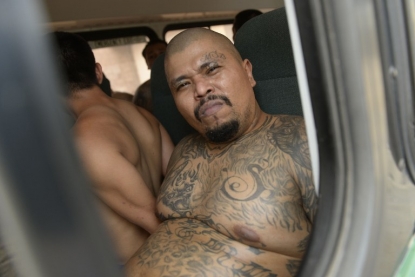 (AFP Photo / Marvin Recinos)
(AFP Photo / Marvin Recinos)As I write these words, I can distinctly remember the prisoners’ eyes as I photographed them. It’s always chilling to be on the receiving end of the cold, hard gaze of a “pandillero”. But it allowed me to show the world something of the cruel reality of my country, such a beautiful place, blighted by the constant, murderous violence of the maras.
In Salvador not a day goes by without brushing up against death. I see death in the eyes of these gang members but also in the eyes of ordinary people forced to live in fear. A fear that paralyses you, and determines your every move.
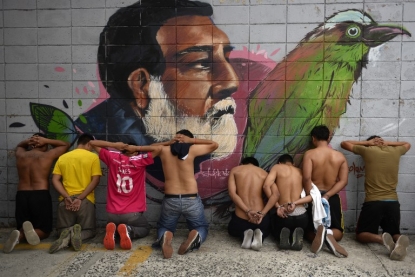 Alleged members of the Barrio 18 gang are detained in San Salvador on May 11, 2015 (AFP Photo / Marvin Recinos)
Alleged members of the Barrio 18 gang are detained in San Salvador on May 11, 2015 (AFP Photo / Marvin Recinos)Official figures suggest there are around 60,000 “pandilleros” at large in El Salvador. Another 13,000 are in jail. The two most powerful gangs, Mara Salvatrucha and Barrio 18, are locked in a bloody turf war to control the drug trade and extortion rackets. But there are smaller gangs too: Mirada Locos, MD, La Maquina, La Mao Mao.
How can you tell who is who? That guy I run into every day at the bus stop – is he a gang member? And that other one, who just asked me for the time. Was he carrying a gun? In Salvador we live from day to day without thinking of tomorrow. Because we never really know who is standing right beside us.
Marvin Recinos is an AFP photographer based in San Salvador. Click here to read the Spanish-language version of his post.
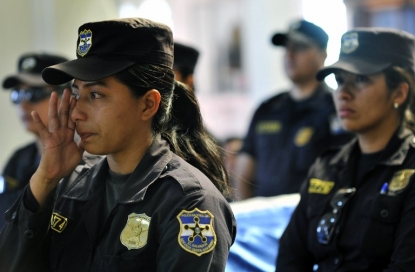 Police attend the funeral of a colleague killed by a gang member, in Zacatecoluca east San Salvador on April 22, 2015 (AFP Photo / Marvin Recinos)
Police attend the funeral of a colleague killed by a gang member, in Zacatecoluca east San Salvador on April 22, 2015 (AFP Photo / Marvin Recinos)

